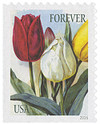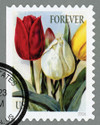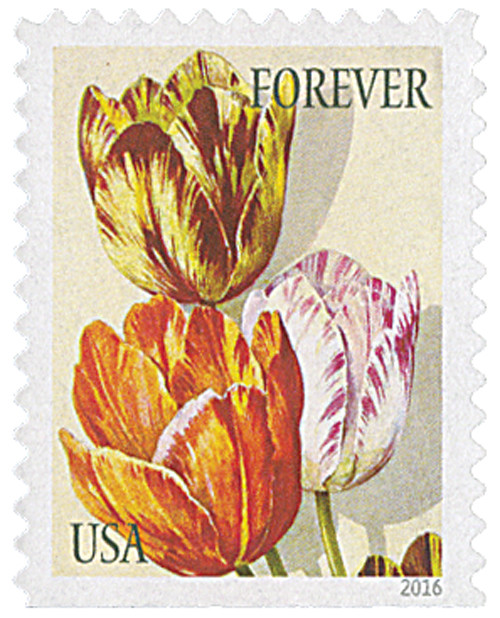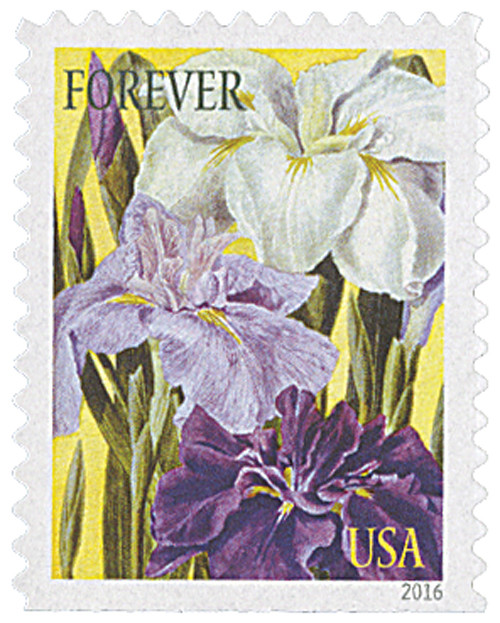
# 5044 - 2016 First-Class Forever Stamp - Botanical Art: Red, White and Yellow Tulips
US #5044
2016 Tulips – Botanical Art
- Celebrates botanical artwork in American nursery catalogs printed between 1891 and 1912
Stamp Category: Definitive
Set: Botanical Art
Value: 49¢ First Class Mail Rate (Forever)
First Day of Issue: January 29, 2016
First Day City: Atlanta, Georgia
Quantity Issued: 60,000,000
Printed by: Ashton Potter
Printing Method: Offset
Format: Booklets of 10 OR Double-sided booklets of 20
Tagging: Nonphosphored type III, block tag applied
Why the stamp was issued: To continue the tradition of printing floral-themed US stamps.
About the stamp design: Pictures tulips from an American nursery catalog printed between 1891 and 1912. The catalog was from The New York Botanical Garden’s Nursery and Seed Catalog Collection.
First Day City: The First Day of Issue Ceremony was held at the American Philatelic Society’s AmeriStamp/Southeastern Stamp Expo. at the Hilton Atlanta in Atlanta, Georgia.
About the Botanical Art set: 10 stamps all picturing different artwork from a 100+ year old American nursery catalog. Species pictured include: corn lilies, tulips, dahlias, stocks, roses, Japanese irises, petunias, and jonquils.
History the stamp represents: The first gardens were cultivated shortly after the Ice Age. After civilizations began to emerge, wealthy individuals started creating gardens purely for pleasure. Some of the earliest evidence can be found in ancient Egyptian tomb paintings, which showed ornamental flowers and shrubs along with lotus ponds.
In ancient times, the Middle East was heralded for its elaborate gardens. Darius the Great, who ruled over the first Persian Empire, was said to have a “paradise garden.” The Hanging Gardens of Babylon, one of the Ancient Wonders of the World, were built around 600 BC for that region’s homesick queen.
China and Japan introduced water features as centerpieces in their gardens. Landscape masterpieces were created around ponds and Zen gardens in Buddhist temples. During the 13th century, formal gardens were popular in France and Italy, followed by landscape gardens in England during the 1700s.
In a garden design manual written in 27 BC, Roman engineer Vitruvius identified firmitas (strength), utilitas (utility), and vesnustas (beauty) as main garden design objectives. Throughout history and across styles, the most celebrated gardens have combined these three elements to bring pleasure to all who enter.
US #5044
2016 Tulips – Botanical Art
- Celebrates botanical artwork in American nursery catalogs printed between 1891 and 1912
Stamp Category: Definitive
Set: Botanical Art
Value: 49¢ First Class Mail Rate (Forever)
First Day of Issue: January 29, 2016
First Day City: Atlanta, Georgia
Quantity Issued: 60,000,000
Printed by: Ashton Potter
Printing Method: Offset
Format: Booklets of 10 OR Double-sided booklets of 20
Tagging: Nonphosphored type III, block tag applied
Why the stamp was issued: To continue the tradition of printing floral-themed US stamps.
About the stamp design: Pictures tulips from an American nursery catalog printed between 1891 and 1912. The catalog was from The New York Botanical Garden’s Nursery and Seed Catalog Collection.
First Day City: The First Day of Issue Ceremony was held at the American Philatelic Society’s AmeriStamp/Southeastern Stamp Expo. at the Hilton Atlanta in Atlanta, Georgia.
About the Botanical Art set: 10 stamps all picturing different artwork from a 100+ year old American nursery catalog. Species pictured include: corn lilies, tulips, dahlias, stocks, roses, Japanese irises, petunias, and jonquils.
History the stamp represents: The first gardens were cultivated shortly after the Ice Age. After civilizations began to emerge, wealthy individuals started creating gardens purely for pleasure. Some of the earliest evidence can be found in ancient Egyptian tomb paintings, which showed ornamental flowers and shrubs along with lotus ponds.
In ancient times, the Middle East was heralded for its elaborate gardens. Darius the Great, who ruled over the first Persian Empire, was said to have a “paradise garden.” The Hanging Gardens of Babylon, one of the Ancient Wonders of the World, were built around 600 BC for that region’s homesick queen.
China and Japan introduced water features as centerpieces in their gardens. Landscape masterpieces were created around ponds and Zen gardens in Buddhist temples. During the 13th century, formal gardens were popular in France and Italy, followed by landscape gardens in England during the 1700s.
In a garden design manual written in 27 BC, Roman engineer Vitruvius identified firmitas (strength), utilitas (utility), and vesnustas (beauty) as main garden design objectives. Throughout history and across styles, the most celebrated gardens have combined these three elements to bring pleasure to all who enter.














